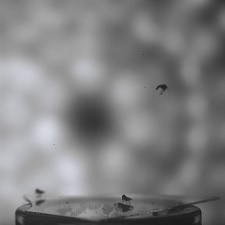Apr 6 2017
According to a team of researchers from Tel Aviv University (TAU), whiteflies open up their wings only after taking off, rotating, and reversing direction in inflight.
 Video still of a whitefly "leaping" before beginning to fly. (Credit: Laboratory of Dr. Gal Ribak.)
Video still of a whitefly "leaping" before beginning to fly. (Credit: Laboratory of Dr. Gal Ribak.)
Measuring just .03 of an inch long, these minuscule insects have several highly developed techniques that provide them with extraordinary stability in the air. The TAU researchers state that these insects may contain the answer to stabilizing the take-off of small robotic flyers such as miniaturized drones.
The research presented at a recent Israel Academy of Sciences and Humanities conference, looked into how whiteflies, which are a part of the order of insects called Hemiptera, magnificently take-off without spreading their wings, which are 28% lengthier than their bodies. The whiteflies just raise their wingtips to provide air resistance and stabilize. The TAU research presentation was built on an earlier study published by the Journal of Experimental Biology.
Whiteflies take a powerful 'jump' before they start using their wings in flight. Then, when the insects are moving through the air, they have to stop the rotation of their bodies to reorient themselves for flapping flight. They are able to do that by extending the tips of their folded wings, causing high air resistance behind the body. This aerodynamic force stabilizes the take-off and only then do the insects spread their wings and start flying.
Dr. Gal Ribak of TAU's Department of Zoology, who led the research.
What is noteworthy here is the response time. All this takes less than 12 milliseconds, and it doesn't require feedback from the nervous system. Nature is providing us with guidance on how to stabilize the take-off of small robotic manmade flyers.
Dr. Ribak
Small but powerful
According to the research, conducted with TAU undergraduate student Eyal Dafni and in partnership with the late Prof. Dan Gerling, TAU Emeritus Professor of Entomology, size is a main component of the insects' effective ascent. Their minuscule size allows them to perform rapid stabilizing responses using the air resistance of various body parts.
The whiteflies leave the ground rotating forward. That rotation should result in the insects somersaulting upon leaving the ground. But the tips of the folded wings provide adequate air resistance, similar to the horizontal surfaces on an airplane tail.
Dr. Ribak
The team used high-speed cameras to film the ascent of the insects for the study. This allowed them to view the take-offs in slow motion and collect 3D data on the motion of the insects. The data was then used to model the aerodynamics and rotation of the insects during ascent. The model showed the tips of the folded wings to be the most significant feature of the stability mechanism.
To test this prediction, we clipped the wingtips of some whiteflies and observed their take-off again. As we predicted, the whiteflies with clipped wings were incapable of stabilizing before spreading and flapping their wings.
Dr. Riba
The researchers are currently exploring other small insects with shorter wings that also jump during ascent but use other mechanisms for stabilizing the leap.
whitefly takeoff stabilization